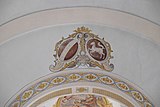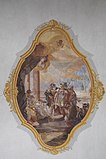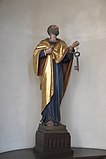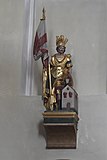St. Florian (Fraunberg)
The Roman Catholic parish church of St. Florian in Fraunberg , a community in the Upper Bavarian district of Erding , was built in the second half of the 18th century on the site of a late Gothic predecessor church. The basement of the bell tower and the assistant figures of the high altar have been preserved from this previous building. The church is dedicated to St. Florian von Lorch .
history
A Romanesque church was probably built in the middle of the 13th century , followed by a late Gothic church before 1500. The present church was built in 1767/69 according to the plans of the Landshut court mason Georg Felix Hirschstötter. When lightning struck in 1775 or 1780, the building suffered great damage and had to be restored.
architecture
Exterior construction
The outer walls are structured by pilaster strips . In the northern corner of the choir rises the tower, whose neo-Gothic pointed spire was built over four gables in 1869. The late-Gothic substructure is broken up by ogival glare fields. The sacristy is built into the southern corner of the choir , the upper floor was formerly used as the patron's box . The entrance is integrated into a small sign framed by pilasters on the southwest side of the nave .
inner space
The interior, a three-axis hall building with bevelled corners, is covered by a needle cap barrel over flat wall pillars. The retracted, two-axis choir is closed in a semicircle. The nave and choir are illuminated by large arched windows, and triple-pass-shaped upper windows are cut into the choir . A double gallery, which was renewed in 1958, forms the western end of the nave .
Ceiling paintings
The ceiling paintings were done in 1908 by the Munich painters Ludwig Ametsberger and Hans Kögl. They are dedicated to St. Florian, the patron saint of the church, and depict his interrogation in the nave and his martyrdom in the choir. The alliance coat of arms of the Fraunberg family with the year of the church renovation in 1908 is emblazoned on the choir arch .
Furnishing
- The high altar , the two side altars, the pulpit and two confessionals were created by the carpenter Anton Fackler from Dorfen in the style of early classicism . On the high altar leaf is propitiatory shown, the paintings of the side altars, left Mary Magdalene , Jesus anoints the feet, right Jesus and the disciples of Emmaus were, of Joseph Hauber executed.
- The candlestick angels are the work of the Rococo sculptor Christian Jorhan the Elder .
- The side figures of the high altar, St. George and St. Florian, still come from the late Gothic altar from around 1490.
- The late Gothic carved figure of the Madonna and Child in the nave is dated around 1500. It is surrounded by two chandelier angels from the 17th century.
- The figures of the apostles Peter and Paul in the nave date from the 18th century.
- The rococo figure of St. Florian was created by Christian Jorhan the Elder.
Epitaphs
In the church there are several grave monuments such as the coat of arms tombstone for Seitz von Fraunberg († 1430) and Lukas von Fraunberg († 1442) and other epitaphs from the 18th century.
organ
The former, no longer preserved organ of the parish church of St. Florian, a pneumatic cone chest instrument with a total of 12 stops on two manuals and pedal , was built in 1938 by Julius Zwirner from Munich . The disposition is as follows:
|
|
|
|||||||||||||||||||||||||||||||||||||||||||||
- Coupling : II / I, II / P, I / P
In 2000 this instrument was replaced by a new one by Paul Rohner from Mallersdorf . This now includes 13 stops on two manuals and pedal.
literature
- Georg Dehio : Handbook of German Art Monuments - Bavaria IV - Munich and Upper Bavaria . 2nd edition, Deutscher Kunstverlag , Munich 2002, ISBN 3-422-03010-7 , pp. 303-304.
Web links
- Parish church St. Florian in Fraunberg on the website of the parish association Reichenkirchen – Maria Thalheim (accessed on August 28, 2017)
Individual evidence
Coordinates: 48 ° 22 ′ 7.9 ″ N , 11 ° 59 ′ 33.9 ″ E












